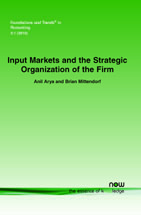Input Markets and the Strategic Organization of the Firm
By Anil Arya, The Ohio State University, arya.4@osu.edu | Brian Mittendorf, The Ohio State University, mittendorf.3@osu.edu
Abstract
Organizational structure of firms is an important topic that has been widely discussed in virtually all management disciplines. The typical view of firm organization emphasizes enhancing efficiency by fully aligning incentives of all participants to achieve a common objective. Over the years, research in accounting, economics, and marketing has stressed how competition in output markets can alter this view. More recently, there has been an emphasis on how a firm's concurrent participation in input markets, wherein strategic supplier considerations are in play, can further alter the traditional view of organizational structure. This monograph seeks to synthesize such results and present the key considerations and conclusions that can be gleaned from this research. In doing so, the monograph emphasizes implications for accounting but also stresses the inherent interconnectivity with issues in industrial organization, strategy, and regulation.
Input Markets and the Strategic Organization of the Firm
The strategic organization of firms has long been a prominent issue in management. Research stressing the importance and ramifications of strategic considerations on firm organization is primarily focused on a firm's strategic relationship vis-a-vis output market competitors. Recent research has widened the focus to the role of organizational structure on strategic relationships in input markets. It is this stream of research that Input Markets and the Strategic Organization of the Firm seeks to synthesize.
Input Markets and the Strategic Organization of the Firm the role of input markets on organizational design into two arenas: how a firm's participation as a buyer in input markets affects existing perspectives of organizational design; how a firm's participation as a seller in input markets alters prevailing views of organizational design. Input Markets and the Strategic Organization of the Firm addresses the question of how strategic firm organization and accounting measurements affect and are affected by such prevalent concerns of relying on an external input supplier. Chapter 2 examines how participation as a buyer in input markets can change views of optimal firm organization. Chapter 3 examines how participation as a seller in input markets alters views of strategic firm organization. Chapter 4 then concludes the monograph while providing a discussion of additional considerations and unanswered questions.
